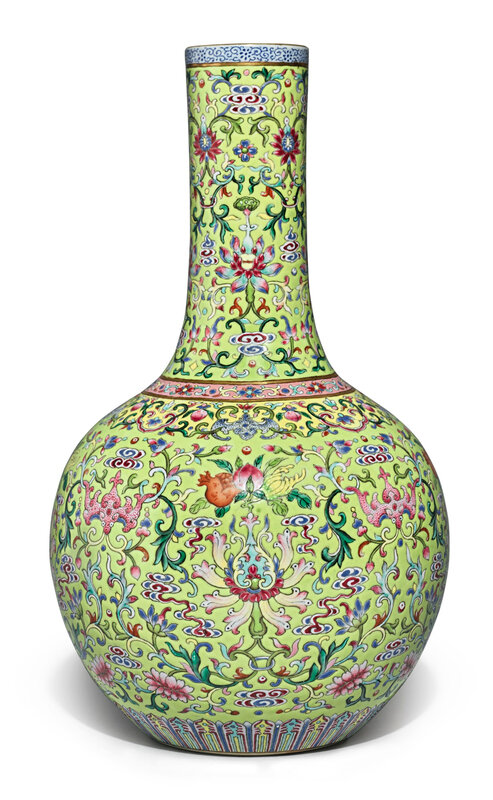A famille-rose lime-green ground 'Floral' bottle vase, Jiaqing seal mark and period (1796-1820)
Lot 545. A famille-rose lime-green ground 'Floral' bottle vase, Jiaqing seal mark and period (1796-1820). Height 12 1/4 in., 31 cm. Estimate: US$200,000 - US$300,000. Lot sold 437,500 USD. © Sothebys
the spherical body rising to a tall cylindrical neck, densely painted in bright and colorful enamels, the body decorated with large lotus blossoms below the 'three abundances' flanked by bats entwined with colorful foliate scrolls amidst cloud wisps, a yellow-ground collar of alternating ruyi and bats interspersed with peaches at the shoulder, the neck painted with further lotus scrolling and auspicious chimes and jewels, the mouth with a band of blue scrollwork between gilt-painted borders and the foot encircled with colorful lappets, the base enameled in turquoise and inscribed with a six-character seal mark in iron red.
Provenance: Sotheby’s London, 15th December 1987, lot 201.
Sotheby’s Hong Kong, 18th May 1988, lot 275.
Note: This vase is striking for its exquisite painting in vivid enamels, and represents one of the classic styles developed at the Imperial kilns in Jingdezhen. The complex and auspicious design is particularly successful. Flowers and leaves are skillfully shaded in pastel tones, leaves are harmoniously entwined with bats, and the three fruits are painted with the skin showing signs of ripening. The surface of the vase is entirely decorated, and the overall effect is of opulence and luxury. Vases of this type appear to have been in vogue at the Jiaqing court, despite the Emperor’s intention to appear frugal. As discussed in the catalogue to the exhibition Lord Jiaqing and the Journey to Taiwan, National Palace Museum, Taipei, 2016, p. 167, Jiaqing and his court ‘consciously played down the aspect of pleasure in art and instead sought to more closely associate court art with the ruler’s resolve to rule diligently’.
Despite the abdication of the Qianlong Emperor and enthronement of Jiaqing in 1796, Qianlong continued to control the administration of the court and influence state affairs until his death in 1799. His active influence is reflected in the production of imperial porcelain wares at the Imperial kilns in Jingdezhen, Jiangxi province, where forms and designs devised in the preceding reign, such as the present vase, continued to be made. These vases emulated the elegant and stylish creations developed at the Imperial Enamel Workshop in Beijing, but were equally influenced by luxurious textiles.
Vases belonging to this group share a number of features, including the iron-red seal mark. They are, however, known in a variety of shapes, with or without handles, and display subtle variations in their designs. The present piece is particularly unusual in its depiction of the sanduo (‘three abundances’) motif emerging from lotus pistils. A highly auspicious design, the pomegranate, peach and finger citron are symbolic of many sons, long life and blessings. The vase also features bats, which when painted upside down make the rebus ‘happiness is arriving’, and lingzhi, the immortality fungus, forming from lotuses at the neck.
While no other closely related vase appears to have been published, related examples with lime-green ground are known. See a slightly smaller vase painted with peaches emerging from lotus and shou characters, from the T.Y. Chao collection, sold in our Hong Kong rooms, 18th November 1986, lot 128; a pair modeled with a flared neck and with a similar design of lingzhi emerging from lotus, sold at Christie’s New York, 11th May 1981, lot 753 and again in our Hong Kong rooms, 27th April 2003, lot 200; another sold at Christie’s New York, 11th May 1981, lot 753; and a further vase lacking the ruyi band at the neck, from the George Weishaupt Collection, illustrated in Gunhild Avitabile, Von Schatz der Drachen/From the Dragon's Treasure, London, 1987, pl. 23, was sold in our Hong Kong rooms, 30th April 1996, lot 509. A variation of this motif is found on a pair of smaller vases with a flared neck and bat handles, sold in our London rooms, 6th December 1994; and a vase with melons instead of peaches sold twice in our Hong Kong rooms, 29th November 1979, lot 253, and 17th May 1988, lot 115.
Related auspicious motifs are also found on vases with other colored grounds; compare for example a yellow-ground vase of ovoid form, similarly painted with the lotus and lingzhi design at the neck, in the Huaihaitang Collection, included in the exhibition Ethereal Elegance. Porcelain Vases of the Imperial Qing, Art Museum, The Chinese University of Hong Kong, Hong Kong, 2007, cat. no. 135; and a turquoise-ground version sold at Christie’s Hong Kong, 30th October 1995, lot 763.
The motif of the ‘three abundances’ emerging from a lotus first appeared on Qianlong mark and period vases; see for example a globular vase painted on a turquoise-ground, illustrated in Taiji Shuichi, Shindai no Jiki/Porcelain of the Ch'ing Dynasty, Tokyo, 1976, pl. 55.
Sotheby's. Important Chinese Art, New York, 20 mars 2019, 10:00 AM

/https%3A%2F%2Fprofilepics.canalblog.com%2Fprofilepics%2F1%2F0%2F100183.jpg)
/https%3A%2F%2Fstorage.canalblog.com%2F03%2F02%2F119589%2F96711876_o.jpg)
/https%3A%2F%2Fstorage.canalblog.com%2F11%2F31%2F119589%2F94773502_o.jpg)
/https%3A%2F%2Fstorage.canalblog.com%2F20%2F83%2F119589%2F94772815_o.jpg)
/https%3A%2F%2Fstorage.canalblog.com%2F26%2F72%2F119589%2F75604929_o.jpg)
/https%3A%2F%2Fstorage.canalblog.com%2F59%2F60%2F119589%2F26458628_o.jpg)





/http%3A%2F%2Fstorage.canalblog.com%2F59%2F39%2F119589%2F129631842_o.jpg)
/http%3A%2F%2Fstorage.canalblog.com%2F77%2F79%2F119589%2F129631259_o.jpg)
/http%3A%2F%2Fstorage.canalblog.com%2F64%2F85%2F119589%2F129631160_o.jpg)
/http%3A%2F%2Fstorage.canalblog.com%2F09%2F41%2F119589%2F129627152_o.jpg)